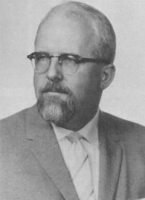










Norman Jefferis “Jeff” Holter was a pioneer in the field of ambulatory electrocardiography, and the inventor of the portable cardiac telemetry device that bears his name and is used worldwide to this day. He famously made a case for continuous ambulatory cardiac monitoring by comparing the collection of heart data with the work of a mining engineer, who “does not assay a mountain of ore by testing one rock.”
Jeff Holter’s words resonate with many physicians who have stood by the bedside of a patient with a suspected rhythm disturbance, only to have a benign-looking electrocardiogram on hand. As a single rock sample cannot reveal the riches of ore within a mountain because of sampling error, a single ECG may not capture a transient symptomatic arrhythmia. Holter’s invention revolutionized the field of diagnostic cardiology by providing a noninvasive way to record the heart’s electrical activity. His technological contributions have since paved the way for devices such as pacemakers and implantable cardiac defibrillators, which allow for management of unstable arrhythmias.
Early Life and his Research Career
Jeff Holter was born on 1 February 1914 in Helena, Montana. He was a science enthusiast throughout high school, pursuing the study of chemistry at the University of Southern California in 1938 and the study of physics at the University of California, Los Angeles, in 1940. He earned a master’s degree in each field and had the opportunity to study nerve conduction testing with Dr Joseph Gengerelli of UCLA.Although he never pursued a medical degree, his foresight would eventually influence the practice of medicine by helping clinicians evaluate and treat cardiac arrhythmias.
During the Second World War, Holter worked as a senior physicist for the US Navy’s Bureau of Ships and conducted research on ocean wave characteristics. His contributions were many, including the development of amphibious operations. He also led a team of oceanographic engineers to Bikini Atoll to perform postwar atomic testing. His Operations Crossroads project looked into the effects of atomic explosions on underwater wave currents.
After the war, Holter returned to his hometown of Helena and founded the Holter Research Foundation, a personally funded scientific endeavor located at the back of the family hardware store. His work included further study and development of electrophysiological telemetry with Dr Gengerelli.
Years before the invention of the modern transistor, Holter succeeded in recording electroencephalographic information from a boy on a bicycle, Albert, with electronics considered large and crude by today’s standards. Due to the technological limitations of the time, the signal-to-noise ratio of encephalograms proved disappointing. The voltage of the heart was known to be significantly greater than that of the brain, providing a much more robust signal. In a move that was as ingenious as it was practical, Holter switched the electrodes from the head to the chest, and cardiac telemetry was born.
Holter’s first radio-electrocardiograph recording was made on a 38-kg device that was strapped on like a backpack. From a practical standpoint, the developing technology had a long way to go before it could be implemented clinically. Short transmission capabilities also limited radio broadcasting of telemetry data. A smaller tape recording device that was developed subsequently could be housed within a briefcase. For the very first time, a truly portable cardiac telemetry device was available. Holter ultimately refined the device, reducing it to a size of 19.5 × 9.8 × 4.6 cm and a weight of 1 kg. Realizing the potential benefit of such a monitoring device, Holter and his colleagues sold the patent to Del Mar Avionics, a well-known airline equipment firm that became the leading manufacturer of the device for over 40 years.6 With increased capital support from Del Mar, Holter was able to refine his invention into a practical clinical tool. The first reported use of ambulatory electrocardiography was in 1954, as published in the Canadian Medical Association Journal. Since that time, thousands of studies and case series have been published involving ambulatory electrocardiography.